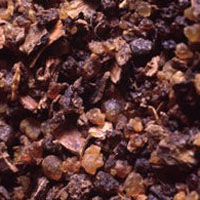Gluten Free
What does following a gluten-free diet mean? That you're embarking on an easy diet with a wide range of health-promoting effects. Instead of dwelling on what you’re giving up, consider that you’re going to enjoy a whole new world of delicious food options to meet your special dietary needs. You’ll be eating seasonally, choosing more fresh fruits and vegetables, focusing on meats, seafood, poultry, legumes, lentils, corn, and rice, and discovering fascinating ancient grains such as quinoa, amaranth, and millet. You’ll be able to eat potatoes, eggs, most cheeses, even chocolate (!)—and enjoy them without guilt because you’ll be taking good care of your body. In fact, you’ll probably end up eating—and feeling—better than ever!
Visit this page for more information about living Gluten Free
---
We carry a large variety of gluten free items, the brands listed below represent just some of the offerings we carry















More Diets
Myrrh
 © Steven Foster
© Steven FosterHow It Works
The three main constituents of myrrh are the resin, the gum, and the volatile oil. All are thought to be important in myrrh’s activity as an herbal medicine. The resin has reportedly been shown to kill various microbes and to stimulate macrophages (a type of white blood cell) in test tube studies.2 Myrrh also has astringent properties and has a soothing effect on inflamed tissues in the mouth and throat. Studies continue on the potential anticancer and pain-relieving actions of myrrh resin.3, 4 Human clinical trials are lacking to confirm most uses of myrrh.
In a preliminary trial, patients with schistosomiasis (a parasitic infection) were treated with a combination of resin and volatile oil of myrrh, in the amount of 10 mg per 2.2 pounds of body weight per day for three days. The cure rate was 91.7% and, of those who did not respond, 76.5% were cured by a second six-day course of treatment, increasing the overall cure rate to 98.1%.5
How to Use It
The German Commission E monograph recommends that persons either dab the undiluted tincture in the mouth or gargle with 5–10 drops of tincture in a glass of water three times daily.6 In addition, tincture of myrrh, 1–2 ml three times per day, can be taken. The tincture can also be applied topically for canker sores. Due to the gummy nature of the product, a tea cannot be made from myrrh. Capsules, containing up to 1 gram of resin taken three times per day, can be used as well.
Copyright © 2025 TraceGains, Inc. All rights reserved.
Learn more about TraceGains, the company.
The information presented by TraceGains is for informational purposes only. It is based on scientific studies (human, animal, or in vitro), clinical experience, or traditional usage as cited in each article. The results reported may not necessarily occur in all individuals. Self-treatment is not recommended for life-threatening conditions that require medical treatment under a doctor's care. For many of the conditions discussed, treatment with prescription or over the counter medication is also available. Consult your doctor, practitioner, and/or pharmacist for any health problem and before using any supplements or before making any changes in prescribed medications. Information expires December 2025.











